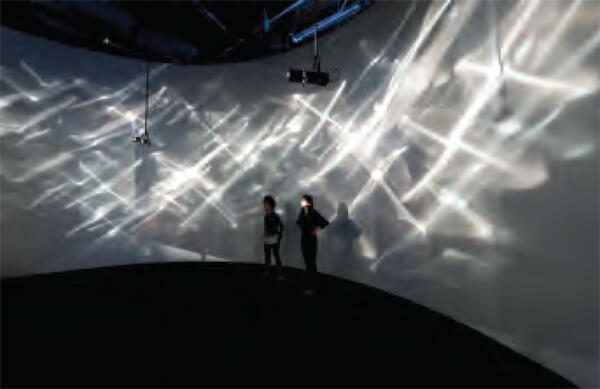Julio Le Parc will inaugurate the new season at the Palais de Tokyo
A pioneer of optical or Op art in the 1960s, a historical figure in Kinetic art and the epitome of an anti-conformist artist, Julio Le Parc defined the principles that would guide his approach very early on: a certain critical analysis of the artist’s situation and social role, the endeavor to go beyond its contradictions through commitment and continual experimentation.

In a 21,500 sq. ft area, Palais de Tokyo presents a selection of key works by Julio Le Parc (paintings, sculptures, installations), showing how topical the practice of this 84 years old artist remains. This exhibition is the opportunity to discover or rediscover his generous, playful, visionary work, from the 1950s to the present day.
The ongoing influence of this artist on younger generations, the rediscovery of an art form that preceded the most state of, the-art technological innovations, and the strength of a commitment that has never wavered make a necessity of this exhibition at Palais de Tokyo, which always keeps as close to artists as possible.
“Generally, through my experiments, I have tried to induce viewers to behave differently (...) in order to find along with the public the means of combating passivity, dependency or ideological conditioning, by developing the capacity for reflection, comparison, analysis, creation, action.”, says Julio Le Parc.
For its new season entitled “Cold Sun” [Soleil Froid], Palais de Tokyo lifts the veil on a paradoxical world illuminated by a strange light where artist such as Julio Le Parc, a historic creator who has influenced many young artists, the guardian figure Raymond Roussel who irrigates a counter-history of art, along with other exhibitions situates Palais de Tokyo a little further into the heart of the fertile paradoxes that sustain artists’ research...
Julio Le Parc was born in 1928 in Mendoza (Argentina). Since 1970 he has lived and worked in Cachan (in Paris). In 1958 Julio Le Parc arrived in Paris thanks to a student bursary; he had been already painting for more than ten years. In 1960, he co-founded GRAV (Groupe de Recherche d’Art Visuel – Visual Art Research Group), and with that group participated in the Biennale de Paris in 1963. On that occasion, he presented a gigantic mobile at the Musée d’Art Moderne de la Ville de Paris, Continuel Mobile, and a collective work, Labyrinthe, composed of a linked sequence of eight cells that plunges the viewer into an interplay of forms and colors, provoking destabilizing perceptional illusions.
Later on, in 1966, Julio Le Parc represented Argentina at the Venice Biennial, and on that occasion received the supreme award, the International Grand Prix for Painting. During the 1960s, in particular within GRAV, Julio Le Parc proved to be the initiator of a large number of contemporary aesthetic modes based on dematerialization, perceptual disorder, formal reduction, artificial light, environments, the involvement of the viewer, or indeed the explosion of visual thresholds, preoccupations that have subsequently become crucial for a number of today’s artists, such as James Turrell, Carsten Höller, Philippe Decrauzat, Olafur Eliasson, or even Anish Kapoor.
Julio Le Parc is a fierce champion of the human rights, denouncing dictatorships in Latin America in the 1970s. His written work, both as a freelance artist and as a member of GRAV, likewise expresses a profound commitment to art with a social dimension and unswerving opposition to institutions and power.
In 1972, when the resonance of his works was at its height, Jacques Lassaigne, the director of the Musée d’Art Moderne de la Ville de Paris, offered Le Parc a major retrospective ranging from 1959. But the feeling of the day favored anti-institutional running battles: after weighing up the pros and cons of such a project, Le Parc said he was “incapable of making a decision”, and threw a coin to settle the question.
Heads, he would accept the invitation; tails, he would refuse it. The coin fell tails: the exhibition did not take place. Subsequently, Le Parc gave his works a different direction, and we would have to wait until the end of the 1990s for his work to experience a new lease of life, intimately associated with the revival of Op and Kinetic art.
Among his most widely noticed exhibitions in recent years, we can mention “Le Parc Lumière”, presented in Zurich (Switzerland) in 2005 by the Fondation Daros-LatinAmerica (travelled to Mexico and Colombia), “Suprasensorial, Experiments in Light, Color and Space” (a collective exhibition) in 2010–2011 at the Museum of Contemporary Art in Los Angeles and in the Hirshhorn Museum and Sculpture Garden of the Smithsonian Institution in Washington (United States), and “Erre, variations labyrinthiques” in 2011 at the Centre Pompidou-Metz (a collective exhibition).
Le Parc was invited to take part in the Nuit Blanche in Paris on October 6, 2012, with two splendid installations, one on the Obelisk of the Place de la Concorde and the other in the Centre Beaugrenelle in Paris. Works by him will be presented as part of the exhibition “Lumineux! Dynamique! Espace et vision dans art, de nos jours à 1913”, that will be held from April 10 to July 22, 2013 at the Galeries Nationales du Grand Palais, Paris.
-
 Lumière en mouvement 1962-1981. Stainless steel, wood, light.
Lumière en mouvement 1962-1981. Stainless steel, wood, light.
Object : 153 x153 x 17 cm. Installation 2011 : 395x620x530 cm with mirors at
right angles. Collection : Julio Le Parc. Photo : Adrian Fritschi for Hatje Cantz. -
 Cellule à pénétrer adaptée (à partir du Labyrinthe GRAV de
Cellule à pénétrer adaptée (à partir du Labyrinthe GRAV de
1963), 1963-2012. Steel, wood, light. Installation : 900x720 cm (height to be
defined). Collection :Julio Le Parc. Photo : Adrian Fritschi for Hatje Cantz -
 Cloison à lames réfléchissantes, 1966-2005. Steel, 232x277x80 cm. Collection : Julio Le Parc. Photo : Atelier Le Parc
Cloison à lames réfléchissantes, 1966-2005. Steel, 232x277x80 cm. Collection : Julio Le Parc. Photo : Atelier Le Parc


